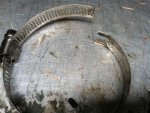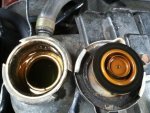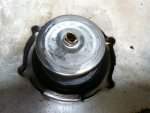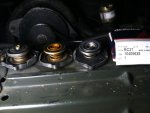jpg
Member
- 611
- 15
- 18
- Location
- Boston, MA
An old mechanic taught me this one, which is useful when you have a small coolant leak and you're trying to limp home, or to a place for repair.
Radiator caps have a spring loaded seal that keeps pressure in the cooling system. If you remove that seal from an old radiator cap, you have a cap that will keep the coolant in, but will not retain any pressure. A small leak leaks much more slowly when there is no pressure in the cooling system.
The seal is not meant to be removable. A little mild violence with something like vice grips will usually allow you to remove the pressure seal while leaving the rest of the cap intact. I'll take pictures tomorrow, when it's light.
I thought my cooling system was finally intact, so I took it on a test drive. I was wrong. The lower radiator hose leaked at the radiator. I pulled into a bookstore parking lot, leaving a trail of coolant behind me. (Yes, we still have bookstores in New England.) I tightened the hose clamp, and it broke. I've mentioned elsewhere that I use torque wrenches a lot because I break things... Fortunately, I had a spare clamp with me.

I pulled the front battery to gain better access. Palpating the hose, I noticed a dent in the rim of the round fitting on the radiator that fits into the radiator hose. I had placed the clamp over that dent, resulting in an incomplete seal. No amount of tightening would have fixed that. I put the new clamp much closer to the radiator, away from the dent. I used 1/4" sockets in hopes of not breaking anything. I used my no-pressure radiator cap, as extra insurance.
I keep an old rifle-shooting mat in the truck, as something to lie on when I have to go under the truck. It's somewhat padded. I folded it in half and laid it across the radiator and brush guard, so I could lie full length along the front edge of the engine compartment, and use two hands to install my hose clamp.
I got home with no evidence of leaking. When I topped off the coolant, it took about a gallon, so I lost quite a bit.
Tomorrow, I go buy more spare hose clamps. I had only one. If I get to the store without leaking, I'll put on the regular radiator cap and see what happens when the system builds up pressure.
This is the second time I've used my no-pressure radiator cap to limp home. I thought others might find this notion useful. The cooling system is designed to work at pressure, but if you have a leak, it's better to have no pressure rather than losing your coolant.
I imagine this trick applies to the bigger trucks too, but I have no experience with them.
Radiator caps have a spring loaded seal that keeps pressure in the cooling system. If you remove that seal from an old radiator cap, you have a cap that will keep the coolant in, but will not retain any pressure. A small leak leaks much more slowly when there is no pressure in the cooling system.
The seal is not meant to be removable. A little mild violence with something like vice grips will usually allow you to remove the pressure seal while leaving the rest of the cap intact. I'll take pictures tomorrow, when it's light.
I thought my cooling system was finally intact, so I took it on a test drive. I was wrong. The lower radiator hose leaked at the radiator. I pulled into a bookstore parking lot, leaving a trail of coolant behind me. (Yes, we still have bookstores in New England.) I tightened the hose clamp, and it broke. I've mentioned elsewhere that I use torque wrenches a lot because I break things... Fortunately, I had a spare clamp with me.

I pulled the front battery to gain better access. Palpating the hose, I noticed a dent in the rim of the round fitting on the radiator that fits into the radiator hose. I had placed the clamp over that dent, resulting in an incomplete seal. No amount of tightening would have fixed that. I put the new clamp much closer to the radiator, away from the dent. I used 1/4" sockets in hopes of not breaking anything. I used my no-pressure radiator cap, as extra insurance.
I keep an old rifle-shooting mat in the truck, as something to lie on when I have to go under the truck. It's somewhat padded. I folded it in half and laid it across the radiator and brush guard, so I could lie full length along the front edge of the engine compartment, and use two hands to install my hose clamp.
I got home with no evidence of leaking. When I topped off the coolant, it took about a gallon, so I lost quite a bit.
Tomorrow, I go buy more spare hose clamps. I had only one. If I get to the store without leaking, I'll put on the regular radiator cap and see what happens when the system builds up pressure.
This is the second time I've used my no-pressure radiator cap to limp home. I thought others might find this notion useful. The cooling system is designed to work at pressure, but if you have a leak, it's better to have no pressure rather than losing your coolant.
I imagine this trick applies to the bigger trucks too, but I have no experience with them.
Last edited:





